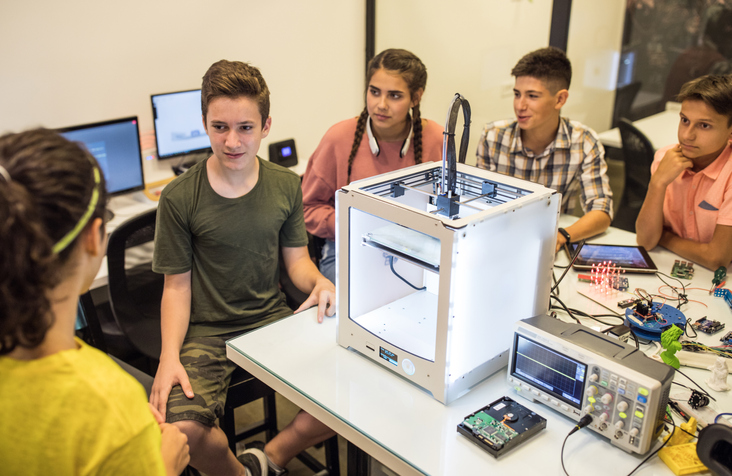Insights is a SmartBrief Education Originals column that features perspectives from noted experts and leaders in education on the hot-button issues affecting schools and districts.
All contributors are selected by the SmartBrief Education editorial team.
Career and technical education has expanded quite a bit in recent years. A couple of decades ago, it typically meant vocational programs offered by high schools to help students who weren’t college-bound earn an alternative license or some other qualification for a job.
Today, CTE programs are offered in middle and sometimes even elementary schools. These programs follow a dual-track model, where students can gain some college credit while they’re still in high school. They also serve as a great way for students who are headed to college to get advanced experience. Here are a few ideas to keep in mind as you launch or expand your own CTE program.
Choosing pathways to offer
Under the umbrella of CTE, there are 16 different career clusters, such as health science, information technology and manufacturing. Within each of those clusters, students can pursue different pathways. Network systems and web and digital communications might be two pathways that fall under information technology, for example.
No pathway or career cluster is inherently better or more useful than the next, so the one that’s right for your school depends on what your students want to do. If a lot of your students are interested in hospitality, for example, a career pathway in restaurants and food and beverage service would better support their interests and career goals than something with a manufacturing focus.
One of the best things about CTE, however, is that so much of the experience students gain is universally helpful and relevant. My daughter, for example, recently completed a medical assisting program where she earned her certified nursing assistant license as a high-school junior. She’s not interested in going into medicine — though she now has the certification for a great job during college if she so chooses — but she still learned and practiced skills critical to her future. She had to do a lot of high-level reading in a college class where she navigated all the higher expectations and greater rigor that she’ll be encountering in the next step of her education.
As part of the program, she went to a nursing home and had the practical experience of interacting with adults on both sides of the patient-caregiver relationship. She had to behave professionally, follow directions, collaborate and practice other soft skills in an authentic working environment.
The practical, hands-on skills of a specific pathway can be a powerful hook to bring students with particular interests into a program, but they are just the very beginning of the benefits CTE offers students.

Career and technical education is for everyone
Regardless of a student’s plans after high school graduation, career and technical education has immense benefits. Research shows that CTE is good for both gifted students and those who need extra support, because it embeds things like additional reading and use of math skills in real-world contexts. CTE requires hands-on learning, which helps students stay engaged, which in turn helps them absorb information better, according to multiple studies. Students who participate in CTE programs have higher rates of attendance and graduation, and even earn more money on average than their peers.
For students who are planning to head to college, some CTE programs offer a fully embedded associate’s degree. With the cost of college tuition, students who earn 30 credits can save a lot of money. Students don’t pay for CTE classes in high school, so if they can cover their elective credits or general education requirements while they’re getting high school credit, why wouldn’t they?
Spreading awareness
CTE programs really feed on connections. They need industry partners to provide guidance, work-based opportunities and sometimes even equipment. You’ll have to let your community know what you’re offering to find more industry partners and generate interest among your students.
Your industry partners are a great place to start promoting your program. They tend to be eager to talk about the good work they are doing in the community by preparing the future workforce and offering educational opportunities to local youth. Talk to them about how they can help you, and then let them run out to tell the world about it.
For example, if you’re launching an agriculture program and you need a milking machine, perhaps your industry partner will give you one. Encourage them to tell the community about their donation, and get that same information into the hands of families through newsletters, social media or whatever channels your school uses. You want family members to know about your CTE program so they will encourage their students to enroll, but family members also work in the community, and their awareness could lead to additional industry partners.
Don’t just rely on the parents — get the students involved too! To get your students excited, hold information nights about your pathways, and make sure your CTE programs are well represented at events like open houses, orientation or back-to-school nights. In the same way band and choir programs go on little tours to engage younger students, visit your district’s middle and elementary schools.
Educators are often nervous about implementing new CTE programs because they imagine a very specific course of study that takes up a lot of space. But it’s worth it to spend the time figuring out how to maximize the space you do have. If your students are really interested in esports, for example, you will need a computer lab with relatively powerful computers. You can use that same space and equipment for a virtual biology lab, an architecture program or a video production pathway. A solid CTE program is worth the extra effort and more because it has the potential to benefit every single student in your buildings.
Opinions expressed by SmartBrief contributors are their own.
_________________________
Subscribe to SmartBrief’s FREE email ASCD newsletter to see the latest hot topics in education. It’s among SmartBrief’s more than 250 industry-focused newsletters.
